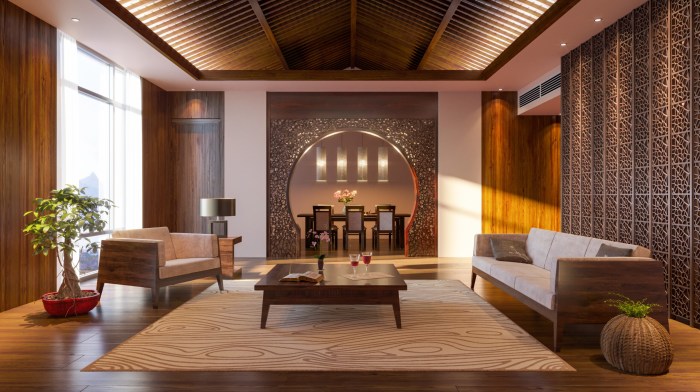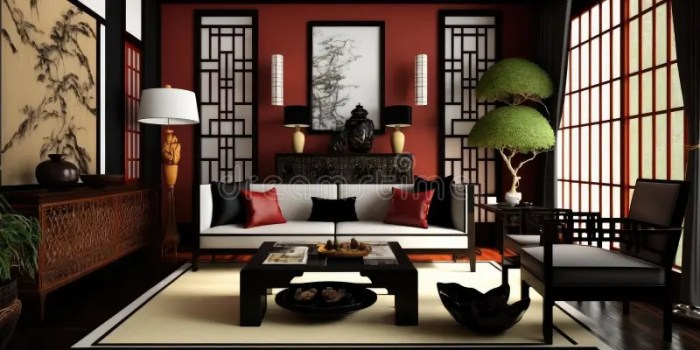Asian-inspired Interior Themes for Modern Apartments

Exploring the essence of Asian-inspired interior themes for modern apartments, this discussion delves into the fusion of traditional elements with contemporary design, offering a glimpse into a world of elegance and sophistication.
From the use of rich materials to the play of colors and textures, the journey through Asian-inspired decor is as captivating as it is inspiring.
Asian-inspired Interior Elements
Asian-inspired interior design often features elements such as clean lines, natural materials, and a harmonious balance of space. Traditional Asian aesthetics emphasize simplicity, tranquility, and connection with nature. These elements can be incorporated into modern apartment decor to create a serene and elegant living space.
Materials
Asian-inspired themes often make use of natural materials such as wood, bamboo, stone, and rice paper. These materials bring warmth and texture to the space, creating a sense of harmony and balance. Incorporating furniture and decor made from these materials can help achieve an authentic Asian-inspired look.
Colors
Colors play a crucial role in Asian-inspired interior design. Soft, neutral tones such as beige, gray, and brown are commonly used to create a calming atmosphere. Bold accents in red, black, or gold can be added to bring a touch of drama and sophistication to the space.
These colors can be incorporated through furniture, textiles, and artwork.
Textures
Textural contrast is another key element of Asian-inspired design. Mixing smooth surfaces with rough textures, such as woven fabrics, carved wood, or stone accents, adds depth and visual interest to the space. Incorporating textiles like silk, velvet, or embroidered fabrics can also enhance the tactile experience and bring a sense of luxury to the decor.
Furniture and Layout

When it comes to creating an Asian-inspired interior in a modern apartment, furniture selection plays a crucial role in setting the tone and ambiance of the space. The right furniture pieces can evoke a sense of tranquility, simplicity, and elegance, which are key elements of Asian design.
Arranging furniture in a way that enhances the Asian aesthetic is essential for achieving a cohesive and harmonious look in your apartment. By following some tips and guidelines, you can create a space that is not only visually appealing but also functional and balanced.
Tips for Arranging Furniture
- Focus on simplicity and minimalism: Choose furniture pieces with clean lines, natural materials, and neutral colors to create a serene and uncluttered look.
- Create a sense of balance: Arrange furniture in a way that promotes symmetry and harmony within the space. Use the principles of feng shui to guide the layout for a peaceful and harmonious flow of energy.
- Include natural elements: Incorporate elements such as wood, bamboo, or stone in your furniture selections to bring a touch of nature indoors and enhance the Asian-inspired theme.
- Consider low seating options: Traditional Asian interiors often feature low seating arrangements like floor cushions, tatami mats, or low-slung sofas to create a cozy and intimate atmosphere.
Space-Saving Furniture Solutions
- Opt for multipurpose furniture: Choose pieces that serve dual functions, such as a storage ottoman or a fold-out desk, to maximize space and functionality in a small apartment.
- Use wall-mounted shelves and storage units: Utilize vertical space by installing shelves and storage units on the walls to free up floor space and keep the apartment clutter-free.
- Consider furniture with built-in storage: Select furniture pieces like beds or coffee tables with built-in storage compartments to provide additional space for stashing away items and maintaining a tidy living environment.
Lighting and Ambiance
Lighting plays a crucial role in setting the mood for an Asian-inspired interior. It can create a serene and calming ambiance that reflects the essence of Asian design.
Natural Light and Artificial Lighting Fixtures
When designing an Asian-inspired interior, it is essential to make the most of natural light. Large windows, skylights, and light-colored walls can help maximize the entry of natural light, creating a bright and airy space. Additionally, artificial lighting fixtures such as pendant lights, recessed lighting, and floor lamps can be strategically placed to enhance the ambiance and add warmth to the room.
Incorporating Asian-Inspired Lighting Elements
- Consider incorporating paper lanterns to add a touch of traditional Asian charm to the space. These lanterns can be hung from the ceiling or placed on tabletops to create a soft and diffused light.
- Bamboo lights are another popular choice for Asian-inspired interiors. These lights, made from bamboo or bamboo-inspired materials, can add a natural and organic feel to the room.
- Rice paper lamps are also a great option for creating a soft and warm glow in the space. These lamps are versatile and can be used as floor lamps, table lamps, or pendant lights.
Decor and Accessories
Asian-inspired interiors are often adorned with decor and accessories that reflect the rich culture and aesthetics of Asian design. From traditional wall art to nature-inspired elements, these pieces play a crucial role in enhancing the overall ambiance of the space.Plants and nature-inspired elements hold significant importance in Asian design, symbolizing harmony, balance, and a connection to the natural world.
Bamboo, bonsai trees, lotus flowers, and orchids are commonly used to bring a sense of tranquility and serenity to the interior. These elements not only add a touch of greenery but also create a peaceful and calming atmosphere.When selecting decor and accessories for an Asian-inspired interior, it is essential to choose pieces that complement the theme and overall design of the space.
Opt for traditional Asian wall art such as calligraphy, silk paintings, or woodblock prints to add a cultural touch to the walls. Screens or room dividers with intricate patterns or motifs can also be used to create separate spaces within the room while adding a decorative element.Pottery and ceramics play a significant role in Asian design, with their unique shapes, textures, and colors adding visual interest to the space.
Incorporate ceramic vases, tea sets, or decorative bowls to enhance the decor and bring a sense of authenticity to the interior.To arrange decor pieces effectively, consider the principles of balance and symmetry in Asian design. Place larger items such as pottery or sculptures as focal points in the room, while smaller accessories like figurines or incense holders can be used to create visual interest on shelves or tables.
Mixing different textures and materials can also add depth and dimension to the space, creating a harmonious and cohesive look.
Last Recap

In conclusion, Asian-inspired interior themes for modern apartments blend cultural heritage with modern aesthetics, creating spaces that are not only visually stunning but also deeply reflective of a harmonious balance between tradition and innovation.
Questions and Answers
What are some key features of Asian-inspired interior design?
Asian-inspired interior design often incorporates natural elements, minimalist aesthetics, and a harmonious balance of colors and textures to create a serene and tranquil space.
How can traditional Asian elements be incorporated into modern apartment decor?
Traditional Asian elements can be integrated through the use of wooden furniture, shoji screens, bamboo accents, and Asian-inspired artwork to infuse a sense of cultural richness into modern living spaces.
What role does lighting play in setting the mood for an Asian-inspired interior?
Lighting is crucial in creating the right ambiance for an Asian-inspired interior, with a focus on natural light, soft glows, and the use of paper lanterns or bamboo lights to enhance the overall aesthetic.

